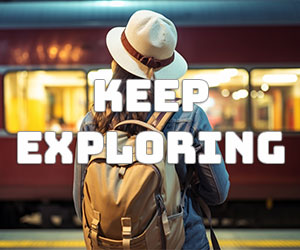You may have heard a lot about the city by the bay and even wondered, what makes San Francisco special? While there are many things to do, what you truly what to know is what makes San Francisco unique amongst all the cities in America.
San Francisco is known by many by different names. Its nicknames include Golden Gate City or, simply shortened down to the Golden City. Locals call it by names that make it easier to refer to. You will often hear of San Francisco being called Frisco, San Fran or simply SF. It has also been called The City by the Bay, or Fog City, references to its geography.
What Makes San Francisco Special and What is it Known For?
Aside from its various names, the city of San Francisco can be found in northern California on the West Coast of the United States. It is located by the Pacific Ocean and is a commercial and cultural hub of northern California and amongst the top 20 cities in the United States of America by population size, and second most populous city in northern California after San Jose.
Here are some things that make San Francisco special.
Size of the City
San Francisco is surrounded on three sides by water. The city is relatively compact and amongst the most densely populated in America. The size of the city means that the majority of San Francisco’s major sites are walkable.
San Francisco’s Chinatown
San Francisco’s Chinatown is the oldest in North America, having been established in 1848. It is demarcated by Grant Avenue and Stockton Street and occupies an area of around half a mile by a quarter of a mile. Along Grant Avenue, you will find the famous Dragon Gate, also known as Chinatown Gate.
The Chinatown in San Francisco has a distinct vibe that reflects the history and culture of Chinese immigrants in North America, brought over by Chinese in the 1850s. It is now seen as a tourist attraction attracting plenty of visitors each year.
San Francisco’s Japantown
Don’t think that Chinatown is the only ethnic neighbourhood worth visiting. San Fran’s Japantown is also worth a visit. It was first settle in the early 1860s and is one of three remaining Japantowns in the United States.
Nowadays, Japantown is a mix of tradition, Japanese food and kawaii culture.
Victorian Buildings

Queen Victoria reigned from 1837 to 1902. There is a distinctive style of architecture associated with that period and San Fran was one of the first major cities to emulate this style.
There were around 40,000 Victorian homes built in the city between 1850 and 1900. However, many of them ended up being destroyed in the 1906 earthquake.
You can still see SF’s Victorian buildings at places such as Alamo Square, also known as Postcard Row, along with famous buildings like the Octagon House at 2645 Gough and the Abner Phelps House, which is also the oldest house in San Francisco, at 1111 Oak Street.
Dramatic Hills
San Fran is built on a series of steep hills. While these may be arduous and tiring to climb, the hills also serve as vantage points that allow visitors to take in fabulous views of the San Francisco Bay and Pacific Ocean.
Karl the Fog
What started off as an anonymous Twitter account has now led to a wider nickname for the infamous fog off San Francisco. The name Karl is actually a reference to the 2003 film “Big Fish” and its giant named Karl.
The fog in San Francisco can come without warning and also disappear just as quickly. It is a consequence of geography and can swirl about dramatically around Alcatraz and the Golden Gate Bridge.
Golden Gate Park

The creation of a field engineer and a master gardener, Golden Gate Park is one of San Francisco’s top attractions with 24 million visitors per year. There are multiple spots to visit within Golden Gate Park including the San Francisco Botanical Garden, the SkyStar Wheel, the de young Museum and Japanese Tea Garden.
For those who would like to seek out more leisurely pursuits, Golden Gate Park’s Strawberry Hill has superb views of the surrounding landscape and Stow Lake offers boat rentals for a view from the water.
The Moving National Monument

It was on Clay Street in San Francisco that the first cable car line in history opened for business in August 1873. 90 years later, San Francisco’s cable cars were designated as the United States’ first mobile National Historic Landmark in 1964.
The modern cable cars maintain a cruising speed of 9.5 miles per hour whether traveling uphill or downhill. The cable cars are equipped with three different braking systems and each car has bells for signalling.
Alcatraz

Alcatraz gets its name from the Spanish word “Alcatraces”. The first person to set foot in what is now known as San Francisco Bay was the Spanish explorer Juan Manuel de Ayala back in 1775. During his exploration, he mapped out the bay and gave one of the three islands the name Alcatraces, which eventually became anglicised as Alcatraz.
The island was used by the army from 1850 till 1933. It was then handed over to the Federal Bureau of Prisons to house the most incorrigible inmates in federal prisons. In response to the crime wave of the 1920s and 1930s, the Federal Government decided to open a maximum-security, minimal-privilege penitentiary.
Eventually, it closed in 1963 because it was becoming too expensive to operated. It was then abandoned up till 1972 when Congress created the Golden Gate National Recreation Area. The island was handed over to the National Park Service and was opened to the public in the fall of 1973. Each year, more than one million visitors flock to Alcatraz to learn about its history and to tour the former penitentiary buildings.
Fisherman’s Wharf
The most visited tourist destination in San Francisco is Fisherman’s Wharf, which extends along the northern waterfront from Ghirardelli Square or Van Ness Avenue to Pier 35 or Kenny Street. It was established in the mid 1800s.
This has resulted in plenty of things to see and do at SF’s Fisherman’s Whart. Famous sights and attractions at Fisherman’s Wharf include Pier 39, Ghirardelli Square, the San Francisco Maritime Museum, Aquarium of the Bay, the Cannery Shopping Center, a Ripley’s Believe It or Not museum, and the Wax Museum at Fisherman’s Wharf.
Among the famous residents of Fisherman’s Wharf are its sea lions. A massive colony can be found on the wooden docks next to Pier 39.
Each year, 12 million visitors make their way to Fisherman’s Wharf.
San Francisco’s Landmarks
What also makes San Francisco special and unique are its famous landmarks and buildings dotted around the city. These include the Coit Tower, the Ferry Building, TransAmerica Pyramid and the Cliff House
Discovering More Things That Make San Francisco Special And Unique
San Francisco is famous for many things and as you explore and discover it, you will discover many more things that make it special and unique to you personally.


